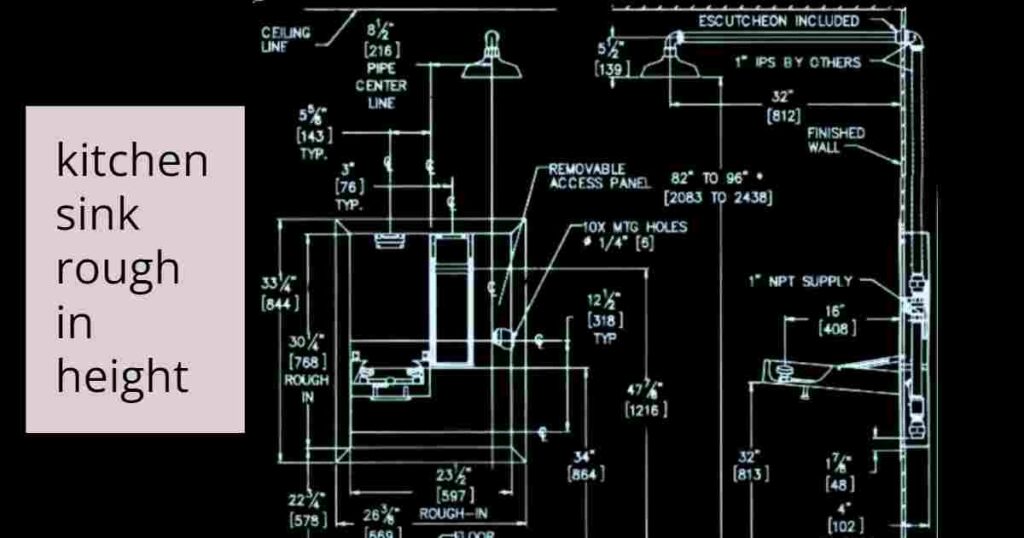Introduction:
The kitchen sink rough in height is the distance from the floor to where the center of the drainpipe to the kitchen sink. It is a starting point for the sink’s plumbing. This measurement helps us that the sink aligns properly with the plumbing system, which is important for good drainage. So, it’s kind of like setting the groundwork to make sure everything fits together correctly when we install the sink.
Basic info
A kitchen sink rough in height, especially in an atoll kitchen, is all about knowing precisely how high the sink’s drainpipe should be from the floor before installation. It’s crucial because getting this height right ensures the sink connects seamlessly to the plumbing system for optimal drainage. This measurement also guides us in planning where to position other plumbing supply lines and drain pipes. So, understanding the rough in height is essential to set up the sink correctly and prevent potential leaks down the line.
The kitchen sink is rough in dimensions
The standard kitchen sink rough in height in inches typically ranges from 18 to 24 inches, although variations may occur based on factors such as the sink’s size and the plumbing configuration.
Kitchen sink rough in height:
Sink center: 24-26 inches above the floor.
Water supply lines: 22-24 inches above the floor.
Drain pipe: 18-20 inches above the floor.
Components:
Sink supply rough in dimensions: This refers to the distance from the finished floor to the water supply lines. It is the proper connectivity for the water supply to the sink.
Sink waste rough-in height: This component determines the position of the sink’s drain relative to the floor. It makes proper drainage and functionality.
Determining the correct height
Determining the right height for the kitchen sink is important for a good plumbing setup. First, we measure from the floor to the center of the drain pipe, as this is the rough in-height reference point. Then we clean the room to the depth of the sink for draining without any obstructions. Also, check the height of plumbing the P-trap and shutoff valves.
It’s a good idea to look into local building codes too, as they might have specific requirements for the rough in height. Overall, take accurate measurements and install all these factors to get the correct height for the kitchen sink rough.
What to avoid during choosing?
To avoid common mistakes when choosing the best height for the kitchen sink, start by measuring accurately from the finished floor to the center of the drainpipe. We consider the depth of sink and plumbing fixtures P-trap and shutoff valves. Besides, always check local building codes for height requirements and we make that there’s enough clearance between the sink and fixtures for easy access and maintenance. By paying attention to these details and double-checking measurements, we prevent misalignment, drainage problems, and compliance violations, ensuring a smooth and successful installation.
How to install it?
- First of all, we measure the distance from the floor to the center of the drainpipe where the sink goes. This is the actual rough-in height.
- And then, clear out space under the sink and we make our room to comfortable to work.
- Put the sink in place, and make centered and aligned with the rough-in height.
- After that we attach the sink’s drainpipe to the main drain line securely, using plumber’s putty to seal any gaps.
- Then connect the hot and cold water supply lines to the sink’s valves under the sink, tightening them with adjustable wrenches.
- We turn on the water and check for leaks. So everything is good. the sink is secure, and clean up any mess, and we can use.
Advantages
- Proper drainage: By setting the correct height, water flows smoothly down the drain, preventing clogs and efficient drainage.
- Prevents leaks: Proper alignment with the plumbing system reduces the risk of leaks, promoting long-term durability.
- Easy installation: Having a predetermined rough-in height simplifies the installation process, saving time and effort during the plumbing setup.
- Compliance with building codes: Adhering to standard rough-in dimensions compliance with building codes and regulations, avoiding potential fines during inspections.
Conclusion:
Mastering the kitchen sink rough in height is essential for a seamless plumbing setup, ensuring proper alignment and efficient drainage. Alongside understanding standard dimensions and plumbing components, such as sink supply and waste dimensions, maintaining composite sinks is crucial. So, how do I clean a composite sink? Accurate measurements, sink depth consideration, and adherence to local building codes are key factors.


